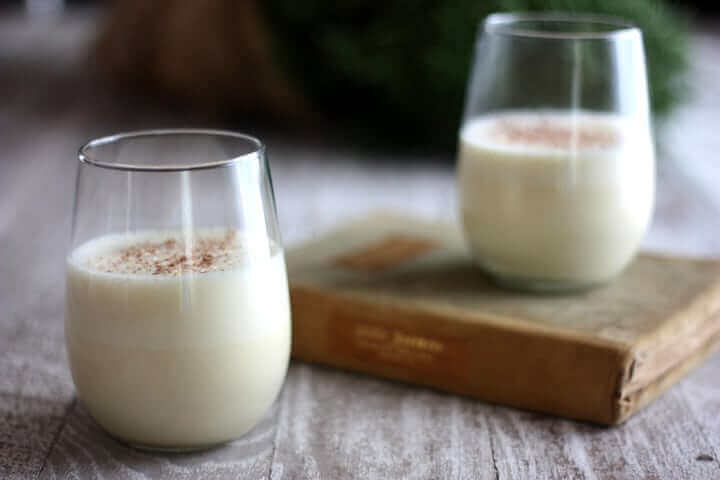
Tis’ the season to whip up a batch of eggnog just like our ancestors used to make – with loads of high fructose corn syrup, artificial flavors, preservatives, stabilizers and carrageenan. What, no? You say that’s not how they made it, and they didn’t make hot chocolate from a pouch, either?
Well then, I think you’re going to love this recipe. Made from wholesome ingredients, this traditional homemade eggnog is smooth, creamy, perfectly spiced, and so easy to make.
There’s one important thing we need to cover about traditional eggnog recipes, though. Most blend raw eggs with cream, sugar, spices and bourbon or rum . . . but are eggs safe to consume raw? What about salmonella?
So, about using raw eggs . . .
No nog lover will be left behind by my recipe, which includes several variations to fit different comfort levels and preferences. We’ll dive into the details in a bit, but here’s some general info I came across while researching awhile ago.
Statistically speaking, it’s estimated that about 1 in 20,000 eggs are contaminated with salmonella, which according to the congressional testimony of Dr. Michael Jacobsen means that the average consumer would encounter a contaminated egg once every 84 years. (1) Other sources say it may be one in 10,000 eggs, which would be about one every 42 years.
Also, melons are more likely to be contaminated with salmonella than eggs . . . weird right? (2)
That’s not to say I’m cavalier about safety. When I kept chickens and knew every single thing about how they were raised, how the eggs were collected, and how they were stored, I had a different comfort level with raw eggs than I do when I buy them at the grocery store (even if they are organic and pastured).
That’s not to say I haven’t had a bite of raw cookie dough or cake batter since then, but specifically regarding eggnog safety here are some perspectives I’ve found helpful:
- The University of Minnesota recommends using pasteurized eggs – meaning they have been light heat treated to kill bacteria – or cooking the eggnog to a minimum temperature of 160F. (3)
- This article in Popular Science says we shouldn’t fear eggnog as long as we make it like our ancestors did – with ample quantities of rum and bourbon that kill bacteria. More on that below.
- Other sources say that eggs harvested from pasture-raised hens are far less likely to be contaminated with salmonella than caged hens. Some research does indicate that salmonella rates are higher in caged hens than free-roaming hens (which may or may not have outdoor access), but I’m not aware of any specific research regarding pastured hens.
Given that, here are some independently validated options for making safer nog:
- Use pasteurized eggs
- Cook the eggnog
- Add alcohol (See the next section)
The Rockefeller Christmas Eggnog Experiment
This might surprise you, but for over fifty years a group of microbiologists from Rockefeller University’s Laboratory of Bacterial Pathogenesis and Immunology have been making eggnog with raw egg yolks and then letting it age for six weeks before finishing it off. (4) MIcrobiologists, y’all.
“I’ve been here almost 50 years, and we’ve made it every year,” professor and lab head Vincent Fischetti told ABC News. “We usually make it about a week or so before Thanksgiving, sip it to cheer Thanksgiving, and finish it at the Christmas party.”
The recipe contains bourbon and rum, which has an antimicrobial effect as the eggnog ages. Out of curiosity, the microbiologists actually added salmonella bacteria to one batch to see what would happen, and the salmonella died as the eggnog aged. (They didn’t serve that batch at the holiday party, though.)
In another experiment, one Rockefeller microbiologist made a batch of nog with 14% rum and bourbon, then let it sit out at 98.6F for just 24 hours. When they compared their homemade eggnog to one they bought at the grocery store, they found the homemade version was completely sterile while the store-bought one was “teeming with a range bacteria.”
Now, the researcher noted that the bacteria were likely harmless, and personally I go out of my way to cultivate good bacteria in my food (in probiotic-rich yogurt, for example). So I’m not saying sterile food is the goal here, only that the alcohol seems to have had a big impact on the microbial population.
With that said, the researcher noted that the experiment would need to be repeated under a variety of conditions in order to definitely prove whether or not spiked eggnog with raw eggs is safe. Fortunately, both raw egg yolks and alcohol are optional in the recipe below.
Oh and also, 14% alcohol can add a pretty strong punch to eggnog, but there’s a way to make it safely with less. (See my recipe notes)
Quick Tips
- If you love nutmeg, feel free to add more. If you’re not a huge fan, use less and consider adding some cinnamon.
- If possible, chill your eggnog in the fridge overnight to let the flavors meld together.
- If you want to make a dairy-free version, use coconut cream and coconut milk instead of regular cream and milk. The eggnog will have a slight coconut flavor, but it’s barely noticeable if you’re adding rum or bourbon. If you don’t want to add liquor and feel like it’s a little to coconut-flavored, try adding a little more vanilla and nutmeg.
- This recipe uses egg yolks only, but you can use the leftover egg whites to make Zimtsterne cinnamon star cookies.
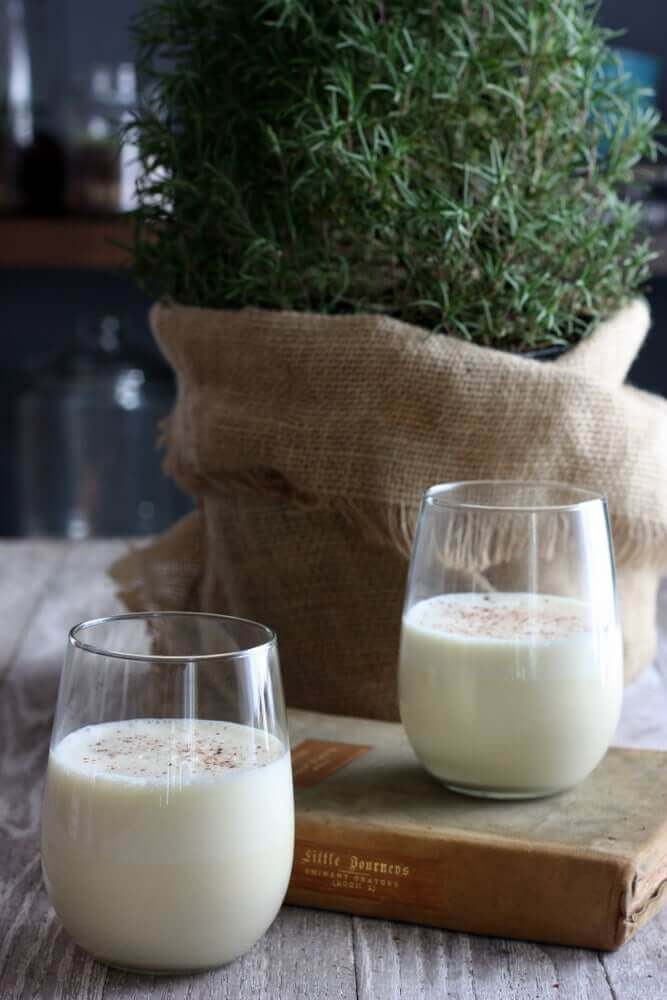
Homemade Eggnog Recipe
Equipment
- Candy thermometer (for cooked version)
Ingredients
- 2 cups cream (Or coconut cream)
- 2 cups milk (Or coconut milk)
- 6 egg yolks (Raw or pasteurized)
- 1/3 cup maple syrup (Or more to taste)
- 2 tsp vanilla extract (How to make vanilla extract)
- ¾ tsp nutmeg (Or more to taste)
- 1 pinch sea salt
- bourbon or rum (Optional – See Notes section for more information)
Instructions
No-Heat Blender Method
- Add the milk, cream, egg yolks, maple syrup, vanilla extract and salt to a blender.
- Blend everything together for about a minute, then add alcohol if using and blend for another 10-15 seconds. Pour the eggnog into a jar with a lid, then place it in the refrigerator to chill. If possible, allow the eggnog to chill overnight so the flavors meld together even more.
- Sprinkle with nutmeg and garnish with a cinnamon stick if desired before serving. Stir before serving.
Cooked Eggnog Method
- In a medium bowl, whisk the egg yolks together with the maple syrup until well-combined.
- Place the milk and cream in a saucepan and on the stovetop until it is steaming but not boiling.
- Take the milk/cream mixture and S-L-O-W-L-Y pour it into the egg mixture while whisking continuously. This is called tempering the eggs, which basically means you're heating them without accidentally scrambling them in the process.
- Return the mixture to the stove top set to low/medium heat. Place the candy thermometer in the pot and continue to heat until the temperature reads 160F, then immediately remove it from heat.
- Stir in the vanilla, nutmeg and salt, then transfer it to a jar and place it in the fridge to cool. If you're adding liquor, wait at least an hour to stir it in.
- Pour the eggnog into a jar with a lid, then place it in the refrigerator to chill. If possible, allow the eggnog to chill overnight so the flavors meld together even more. Stir before serving.
Notes
Notes On Adding Rum Or Bourbon
You can add rum or bourbon to taste, or if you’re interested in using alcohol to increase the eggnog’s safety profile you can adapt this method described by Cook’s Illustrated. It tastes pretty strong, so when I made it with this method I ended up diluting the final product just before serving with a little more cream, maple syrup and nutmeg to taste. The process looks like this:- Use at least 1.5 ounces of 80-proof liquor for every egg (Three yolks are roughly equivalent in volume to one whole egg, so for the six egg yolks in this recipe the amount of 80-proof liquor to use would be 3 ounces. )
- Mix the alcohol, eggs, and maple syrup together and don’t add the dairy. Allow mixture to age.
- When you’re ready to serve, add the dairy, vanilla, nutmeg and salt to a blender along with the egg mixture and whip on high for one minute.
Nutrition
More Recipes
Eggnog Latte – Based on the eggnog recipe above, this latte has been adapted a little to help the flavor blend better with coffee.
Hot Apple Cider – This spiced cider is super easy to make and can also serve as the base for buttered rum.
Sources
1. Senate hearing. Egg Safety: Are There Cracks In The Federal Food Safety System?
2. Popular Science (2017) Don’t worry about eggs—these other foods are way more likely to give you Salmonella
3. University of Minnesota. Making homemade egg nog that’s safe.
4. Popular Science (2013) Why You Shouldn’t Fear The Eggnog

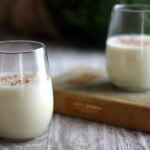
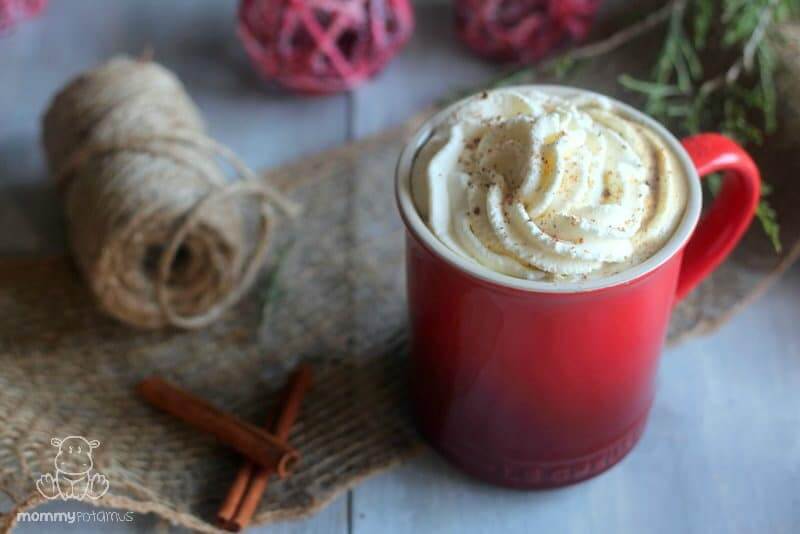
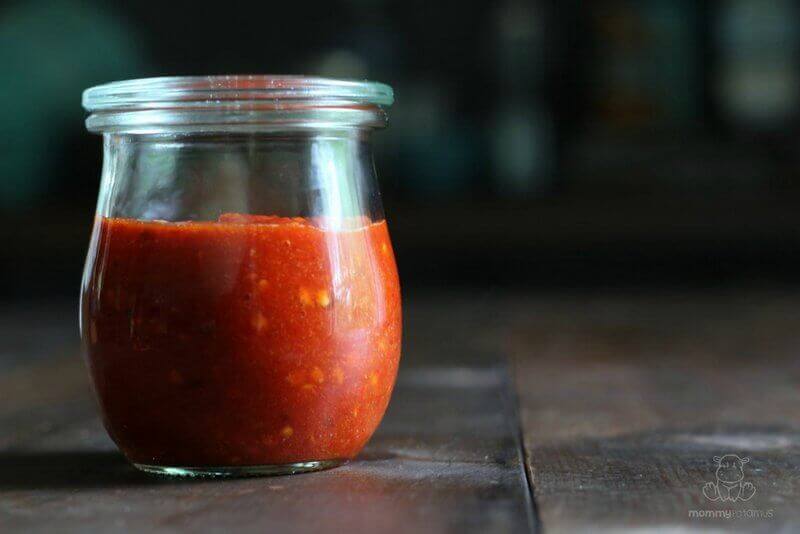

Sounds delicious! Can’t wait to try it. Out of curiosity, why did you make the switch to the Vital Proteins gelatin hydrolysate? I haven’t heard of that brand before and am wondering why you decided to switch. I use Great Lakes. Thanks!
I agree! Heather please, please write a post covering this.. I beyond interested!!
Ahhh, that’s a great question! There are several reasons I switched. Putting it on my list of things to blog about asap 🙂
Love homemade eggnog and I follow Mommypotamus regularly. I was just about to ask the same question as Carli. I use Great Lakes as well but I am very much interested in why you like this one more. Thank you in advance.
how do you print recipes
Vital is made from non gmo snapper and great lakes from cows. I’ve heard from some that snapper collagen is better… but I haven’t done enough research to form my own opinion.
I know it’s untraditional, but I love eggnog with Amoretto. Any good options for that? (Also, this is pretty much unfriendly for those expecting, isn’t it? Sigh)
I drank w/all three of my pregnancies… some wine or beer w/dinner, or an occasional mixed drink… all my kids have IQs over 130… so I don’t see any brain damage.. they are healthy, productive working adults… they are now 51, 50 and 47… so I don’t see the big brouhaha and fuss they make now about women drinking alcohol while pg. maybe it is because the ingredients in the alcohol have changed… like high fructose corn syrup…. and corn being a GMO product.
I was told by one of my midwives, that the “absolutely no drinking in pregnancy” thing really comes from the fact that NO ONE has ever studied the effects of moderate, responsible drinking on pregnant women, and their babies in utero (I hate the term “fetus”). The studies that have been done with drinking are ALL on over-consumption, and levels that would qualify as intoxicated.
They kind of just recommend to avoid all alcohol “just in case”, but of course if you’re a responsible adult who knows their body well, and certainly doesn’t make a habit of over-consuming alcohol at all, the odd drink in your pregnancy can actually have benefits.
I had a midwife suggest to me that I should drink a bit of wine each day, because the stress of some situations was more damaging to my body than the alcohol would be–and it would help relax me. Also, I’m pretty sure I once in a while took a bit of beer with some of my others, but I definitely made a point to never consume ANY alcohol when around others, or certainly in public–for the impression, you know…..
I noticed you and Wellness Mama recently switched gelatin hydrolysates. I began taking the Great Lakes collagen based on the information provided by both of you. Can you inform us why this one is better? Thanks!
How long would this keep in the fridge in an airtight bottle? And I’m also curious to know why the gelatin switch.
I’m with everyone else: Why the switch from Great Lakes?
I’ve never heard of putting gelatin in egg nog and we use 12 egg yolks not just 6-8! 🙂 Great way to get in some more gelatin though. I wanted to add that if you have to use pasteurized milk or cream at the very least make sure it’s not homogenized or have other additives. I feel bad for the people who live in states where their milk supply is very limited.
Haha! Yes, I find ways to get gelatin in as much as possible. A twelve yolk nog sounds divine. 🙂
Just curious as to your opposition to homogenization?
How does it taste using coconut milk and cream instead? I hate to waste a can of coconut milk if it’s gonna be terrible 😂
Looks like a great recipe! I’m excited to make it for my family. I, myself cannot have dairy. Has anyone tried this with some other type of milk? I was thinking full fat coconut milk maybe?
I know this is way late, but for anyone else who happens across this…
Mark Sisson’s of Primal Blueprint fame has an eggnog recipe on his site that uses coconut milk (canned or fresh, not carton). His is a low-heat “cooked” variety, but shows that it can be done. Other nut milks can be used at least for the milk part, but you’ll need the extra fat of coconut or dairy cream to get the creaminess, most likely (though you may be able to achieve it with more egg yolks).
I just made this, still using cream, but subbed the milk for BPA-free (full-fat) canned coconut milk. I sweetened with Grade-B maple syrup, used the gelatin, chilled, and generously topped with nutmeg, and it.was.delicious!! So so happy to make one of my favorite holiday drinks, without making me feel crappy. Yum yum, thank you!
Just made this. So easy and so delicious! My kids LOVE it! Thanks!
Excellent eggnog…in years past I’ve actually ordered some from an Amish farmer and shipped it as a holiday treat. I just made it this Christmas morning. I won’t be spending the extra $$ anymore to ship it. Thank you for a truly rich and delicious treat! Merry Christmas!
So happy you liked it, Karin!
Yeah…you can literally just put cream, sweetener, spices & eggs in a blender. Easiest drink ever. You don’t even need all these steps.
How long will the eggnog last in the fridge? Do you know how long egg whites will last in the fridge? I have a bunch of them now and would like to use them. Just want to know how long I safely have.
Hi, I’m wondering if the milk could be substituted with coconut milk and the cream with coconut cream instead. Has anyone tried this?
Danika, I’ve made it with coconut milk instead of the raw milk, but I still used the cream. It was delicious!! I’d imagine you could also use coconut cream in place of the cream though.
Could we use powdered eggs instead of fresh? Make it safer?
If you’re using fresh pastured eggs from a trusted source, they are perfectly safe. 😉
@ ali: You honestly believe that POWDERED eggs are safer??? OMG!
Hey D.Smith, I’m curious as to why you imply that powdered eggs are not safer than raw eggs. Could we please have a link to scientifically proven facts, rather than just your ranting of personal opinion? Yeah – facts – what a concept. FYI, the FDA does state that dried (powdered) eggs are safer than raw eggs. I’m sure you despise the FDA, but thought I’d put it out there for the original poster who you berated simply for asking a question and being cautious with their and/or their family’s health. As for me, my grandmother told me to just add some alcohol to make sure nog was safe.
https://www.fda.gov/Food/GuidanceRegulation/GuidanceDocumentsRegulatoryInformation/Eggs/ucm332850.htm
Adding eggnog to your coffee or making an eggnog latte isn’t weird! It’s delicious and one of my favorite things. 0:)
What can I do with the leftover egg whites? 🙂
Egg white omelettes are my favorite way to use up left over egg whites. Or make Pisco Sour 😉
Make coconut macaroons!
Raw eggs are really good for your skin. Egg whites make a great face mask alone or I mix with mashed banana, raw apple cider vinegar or plain yogurt.
Freeze them for later use. angelfood cake or seven minute frosting etc.
Beautiful drink. Tastes great with Malibu!! ?
I saw an egg nog recipe on Home and Family Christmas in July today 7/11/17
But I can’t find it anywhere can you help me?
Heather, would you drink this if you were pregnant?
How long will this stay fresh in the fridge?
Hi, can you please tell me how long this will keep in the fridge?
Heather, your eggnog is the best!! We drink it every year at Christmas since your first post!
Thanks so much!
Ahhh, I’m so happy to hear that! Thanks for taking the time to let me know, Karin. 🙂
I currently don’t have any gelatin, will it greatly affect the recipe if I omit?
I noted that many comments asked about gelatin: but I don’t see gelatin in the ingredients list or in the directions????
You must have updated this post and changed the recipe, yes?
Yes it did. I sometimes add 1-2 tablespoons of collagen peptides (the kinds that dissolves in cold water) for a nutritional boost but I found that mentioning that in the recipe led to some confusion so I took it out. 🙂
This looks amazing!! Thank you so much, and I can’t wait to make it!! I loooove eggnog, and especially nutmeg!!
Regarding the raw eggs, have you ever watched Napoleon Dynamite…. they drank pitchers of raw eggs at the chicken farm…. gross! Thanks again for all of your amazing recipes and merry Christmas
An old boyfriend’s mother would separate her eggs and yolks, make up the eggnog as here, but then fold in the whipped egg whites. That was the best eggnog ever! Is there a reason to not use raw egg whites? I don’t remember if she cooked her eggnog or not.
I LOVE egg nog. One of my recipes uses the egg whites — you whip them with a little sugar and then fold it into the nog for a fluffier mixture. It’s lovely.
Did this recipe previously contain gelatin? I’m seeing a lot of comments about that, but not seeing any gelatin in the ingredients list. I love adding gelatin to stuff so would love to see a recommended amount. Thanks!
Yes it did. I sometimes add 1-2 tablespoons of collagen peptides (the kinds that dissolves in cold water) for a nutritional boost but I found that mentioning that in the recipe led to some confusion so I took it out. 🙂
if you use the coconut cream and milk would the carbs and sugar be the same? Looking for a keto version. Thanks
No, the nutritional profile will be different.
Love this eggnog recipe!!! Been making it for years!